Blog 2
1st – 5th May
Total Distance: 569km
Day 1 – Cape Byron to Kyogle
1st May
113km (1497m climbing)
The forecast for 1st May was for a high chance of rain and thunderstorms. As we drove up to the Cape Byron Lighthouse at Australia’s most easterly point, the weather was pretty wild with heavy grey clouds and a likely downpour approaching from over the Pacific Ocean. There was just enough time to get a few shots and for Gavin to film the departure. I was feeling excited that the start was finally upon me and there was nothing else to do except ride. I set off as planned just after 8am, support team following, down the steep hill (on which the lighthouse stands) and through the town. Once I was through the busy streets and turned off along the Bangalow Road towards Lismore, I could relax somewhat and try to concentrate on finding some rhythm.
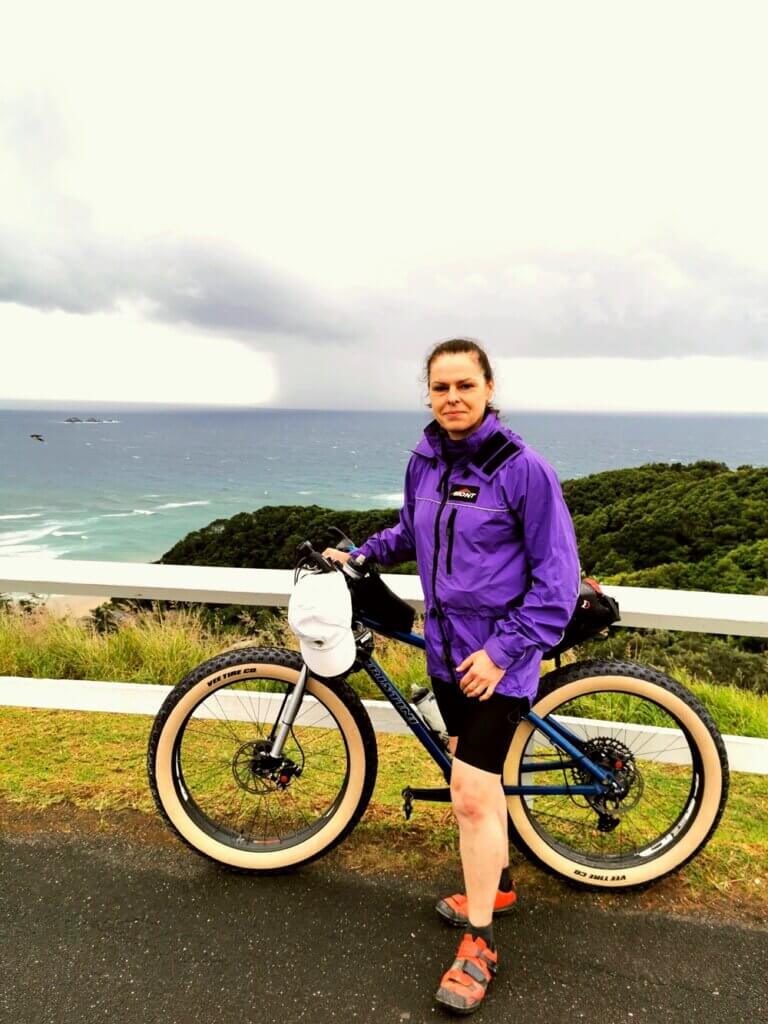
Day 1 was always going to be a challenge, heading east through Bryon Bay’s hinterland and into the Great Dividing Range. I knew the terrain would be steep but I had organised to squeeze in a project visit before reaching Kyogle, the destination for Day 1. Having not had any time to train over the last couple of weeks, I was anxious about making a success of the first day and not wiping myself out for the following days. For essentially 11 weeks I will have to back up day after day (with occasional rest days) and hoped I wasn’t being too ambitious.
The Bangalow Road was busy with traffic all the way to Lismore (48km). The foothills of the Great Dividing Range can just about grow anything. This fertile region is home to the native macadamia nut and I passed many farms.
From Lismore I turned north towards Nimbin and then veered onto a more minor route along the Jiggi Road and Mountain Top Road – the name Mountain Top was apt for the first really long steep climb, one of four big challenges for the afternoon. Just as I hit the gravel, the rain started to fall, ensuring that by the time I finally reached Margaret’s property on Stoney Chute Road, my new white expedition cycle jersey was suitably spattered with mud.
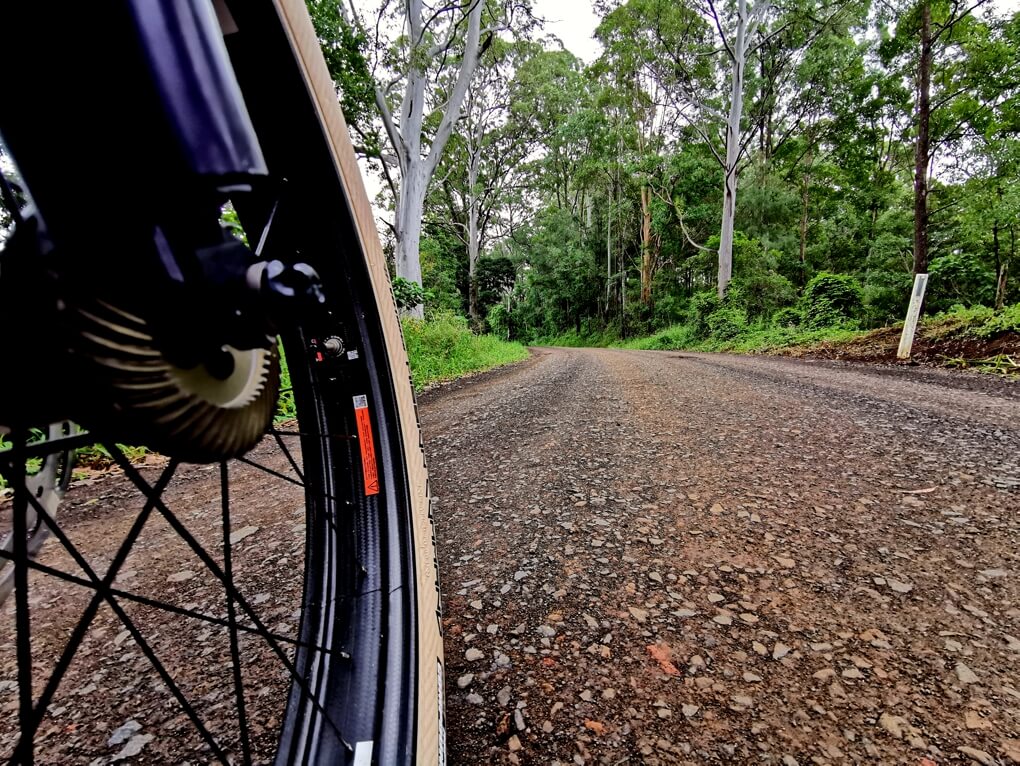
Margaret had recently destocked her 100 acre property of cattle. Working with Carbon Positive Australia (whom I am working with for this project) Margaret aims to provide an additional corridor of tree planting. The corridor will allow species to move as they always have done from one area to another and help to protect the biodiversity of the region. Threats to species such as koalas, kangaroos, snakes and many other native animals come from loss of habitat from development, land clearing and bushfire. Margaret first plans to revegetate a 29 acre region and eventually much more of her land to also encourage further natural regeneration.
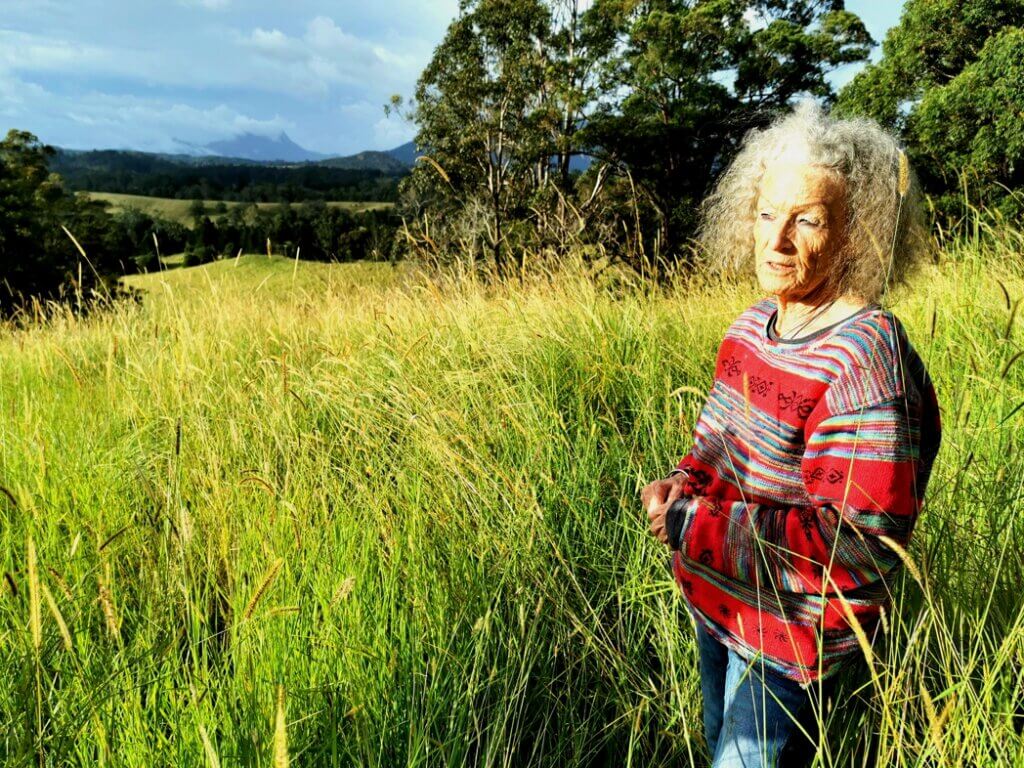
It was only a short visit as Margaret spoke with passion and eloquence about doing her bit to protect the environment she loves. The views from the shed at the top of the property were stunning, looking out at Wollumbin (Mt Warning). Margaret explained some of the significance of the sacred mountain, an ancient volcano. Wollumbin means ‘cloud catcher’ to some Aboriginal People, is a traditional place of cultural law, initiation and spiritual education for the people of the Bundjalung Nation.
Margaret’s belief is that everyone needs to take responsibility to caring for the environment, to put back more than they take out. To find out more: https://carbonpositiveaustralia.org.au/our-work/nimbin-nsw/
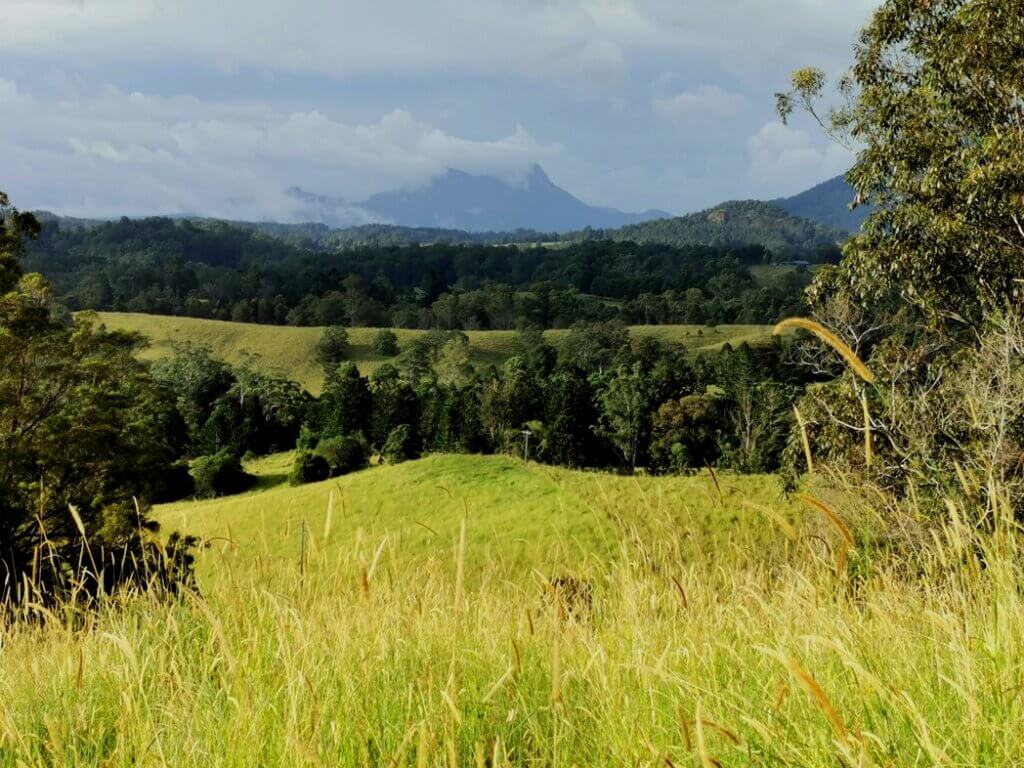
I could have stayed much longer, but I still had two more big climbs ahead of me. The final 28km to Kyogle was a race against the setting sun. A race I lost as I ran out of light and energy on the final climb. Still, I was pleased to make it to Kyogle in the dark, just after 6pm, the last few kilometres by the light of Neil’s vehicle.
Day 2 – Kyogle to Legume
2nd May
104km (1393m climbing)
Out of Kyogle I followed the Richmond River valley, first to Wiangaree (where Greg Yeoman and I stayed on the floor of a disused honey factory in 2004! There was almost as much climbing on Day 2, however the gradients weren’t as severe as I followed the Summerland Way and on to the Mount Lindesay Road to Woodenbong. It was a gradual climb up the valley and then and over some steeper hills and fun descents back to the next valley. This was once a volcanic landscape, now just the remnants of the volcanic plugs that point spectacularly to the sky.
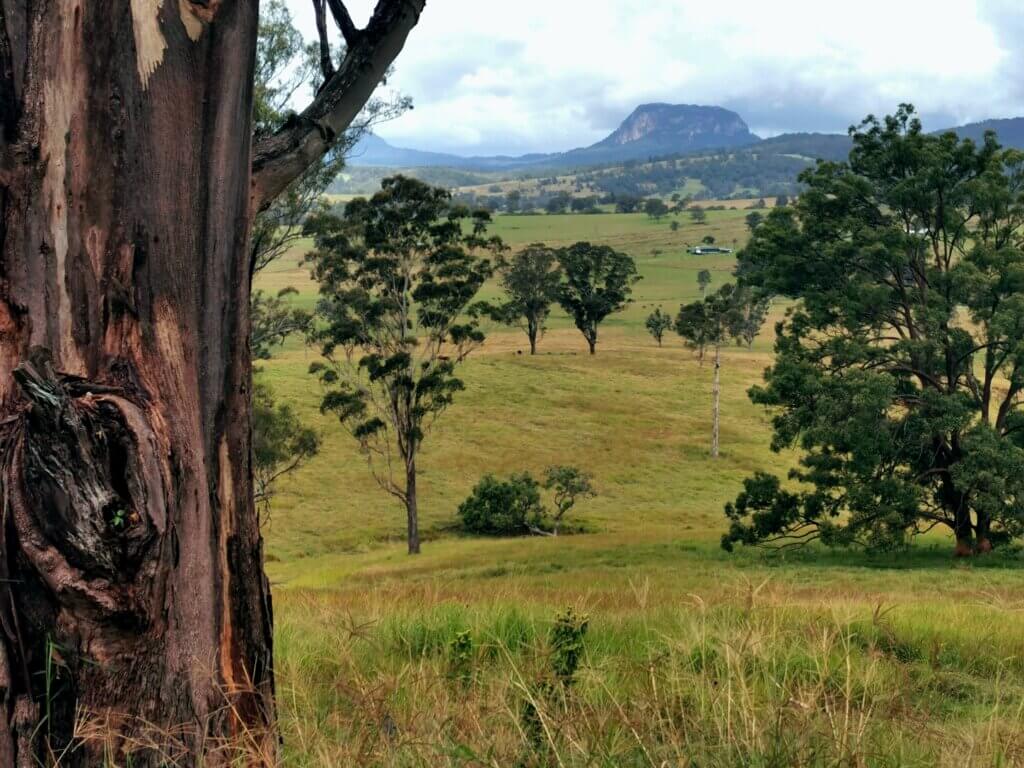
Night 2 was spent camping on the edge of the hamlet of Legume.
Day 3 – Legume to Pike’s Creek
3rd May
102km (1105 climbing, 32km gravel)
My legs were starting to feel a little worse for wear after the rigours of the first two days as Ii headed off into a misty morning along the Mt Lindesay Road. The first highlight for me was when we turned off the tarmac and onto a short cut, 32 km across dirt tracks, passing paddocks of cattle, even a donkey tried to follow me. As the clouds passed across an otherwise sunny sky, the cloud shadows dappled the landscape.
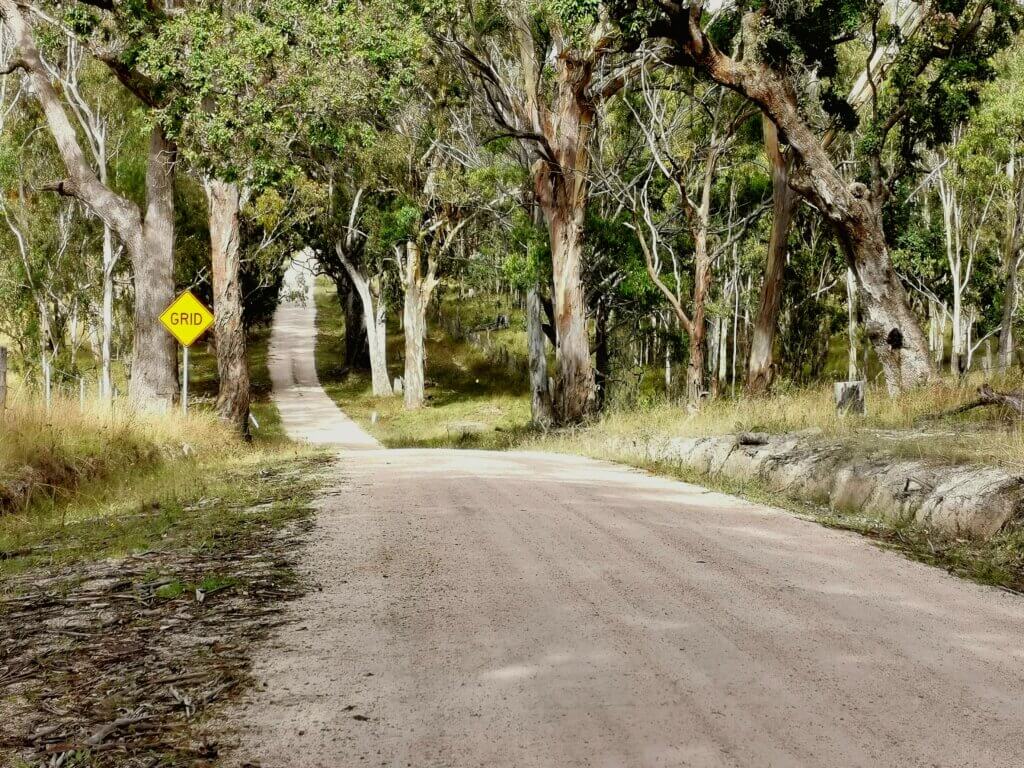
At the end of that track we found we had entered Queensland, hitting an unpleasantly busy highway connecting the two states. After Stanhope, I turned right on the Texas Road that bisected forest plantations, a bush reserve as I gradually gained altitude. The highlight of the day was the campsite Martin found besides Pike’s Creek. It was a beautiful long billabong, where the perfect white tree trunks were mirrored in the still waters.
Neil’s sister Sue and husband Bill and then Gavin’s partner Mel and their son Abel both paid us a visit at the camp spot on their ways to and from Queensland.
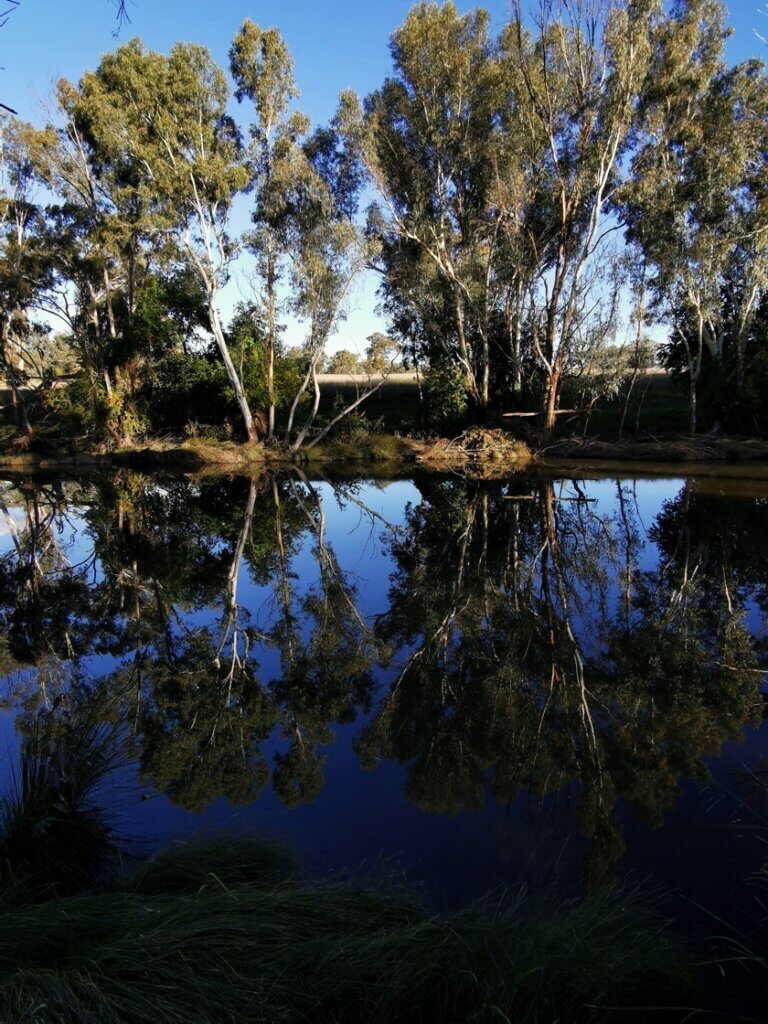
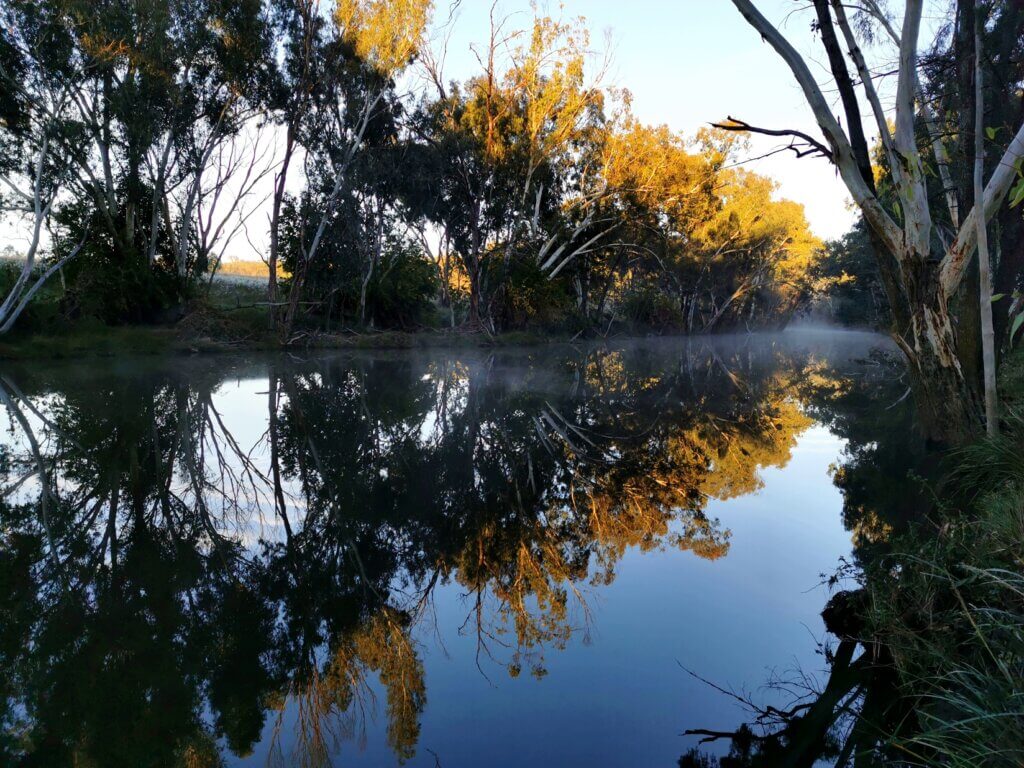
Day 4 – Pike’s Creek to North Star
4th May
142km (1361m climbing, 42km gravel)
Knowing that I was pretty much through the Great Dividing Range, I planned to cover bigger distances over the next two days to reach Moree, but Day 4 turned out to be more than I bargained for.
Firstly, as far as the steep hills went, there was a 30km long sting in the tail, coupled that this was the fourth arduous day in a row. After that, the land gradually flattened. About 20km from Texas, I stopped at the remnants of an abandoned mine at Silver Spur. I would have loved to investigate further but the area was fenced off as there were open shafts amongst the ruins. The area was a hive of mining from 1892-1914, where zinc, lead, silver, copper and small amounts of gold were found.
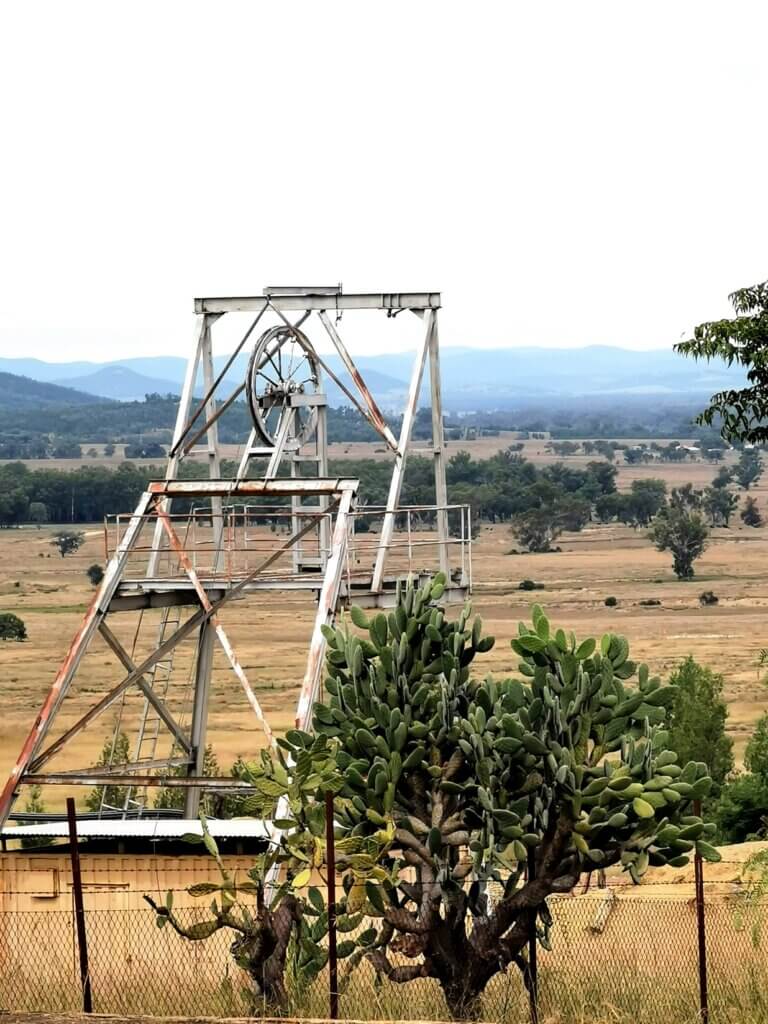
Texas, was the last town before crossing the Dumaresq River and back into NSW, had a very interesting museum dedicated to the Texas Rabbit Works. In the 1930’s trapping and processing rabbits, introduced and in plague proportions in the region (and across Australia), helped to sustain the local economy. Between 1930 and 1960, the Rabbit Works processed 6000 rabbits a day, for pelts and meet.
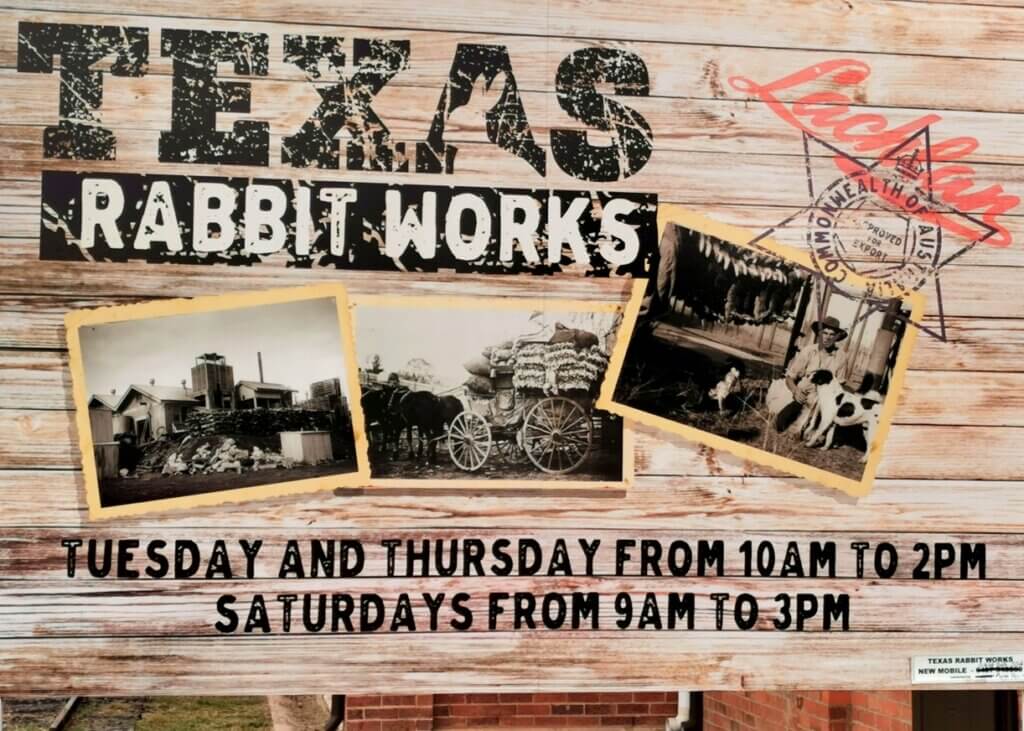
After Texas, the landscape did flatten out (in general) and I was doing well until the skies turned to gunmetal grey and I had to ride through a thunderstorm – I was soaked by the time I reached Yetman, but the challenge had only just begun.
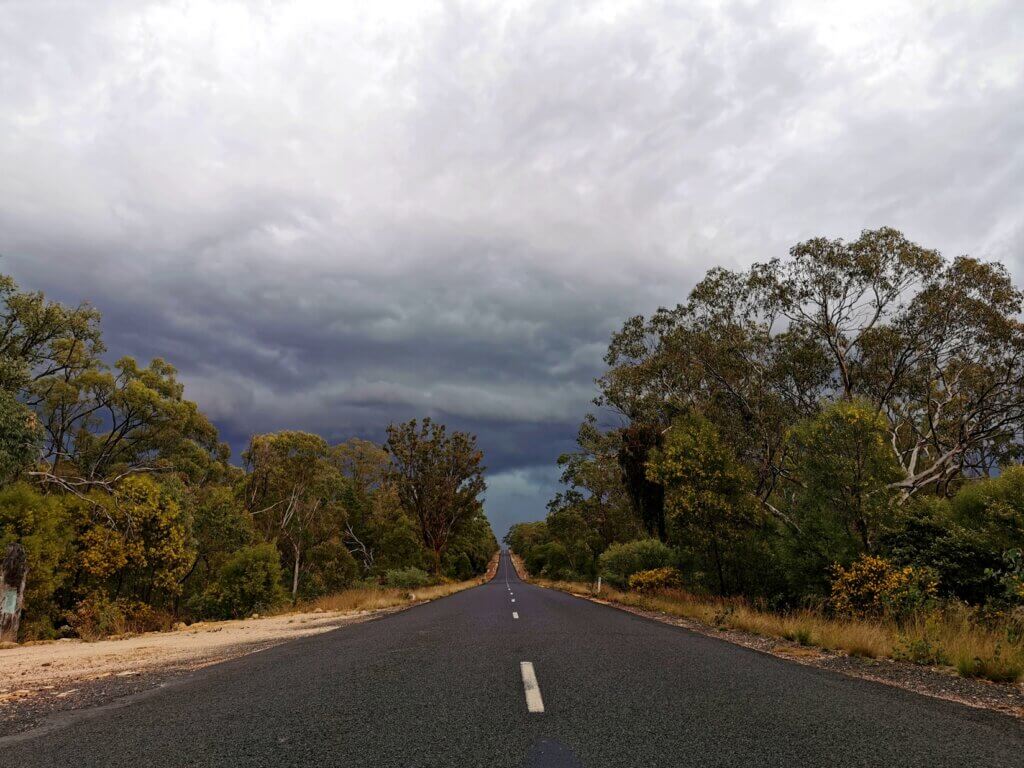
I thought the road to North Star, my planned destination, might be minor, but in the rain, it was very slow going. Through the bushland, it was covered in large stones, probably to hold the mud at bay. Then the track reached the Gwydir Shire and I entered the flat, chocolate brown, fertile plains and my path became a little faster. In the end, I did 42km on the muddy surfaces to reach North Star in the dark.
Day 5 – North Star to Keytah Farm (30km west of Moree)
5th May
108km
In the daylight, I could really noted the vastness of these flat prosperous plains. I spotted all sorts of broad scale land use; crops such as cotton, wheat, legumes, sorghum and large cattle properties. I set off know that hail was forecast and an icy blast hit about an hour after I started. I had not been expecting such an arctic turn on this journey. At one point I struggled to go forward, the wind was so strong and the rain was ice-cold. My feet and hands were numb by the time I reached the support team. I ended up wearing Neil’s oily work gloves just to keep the cold off.
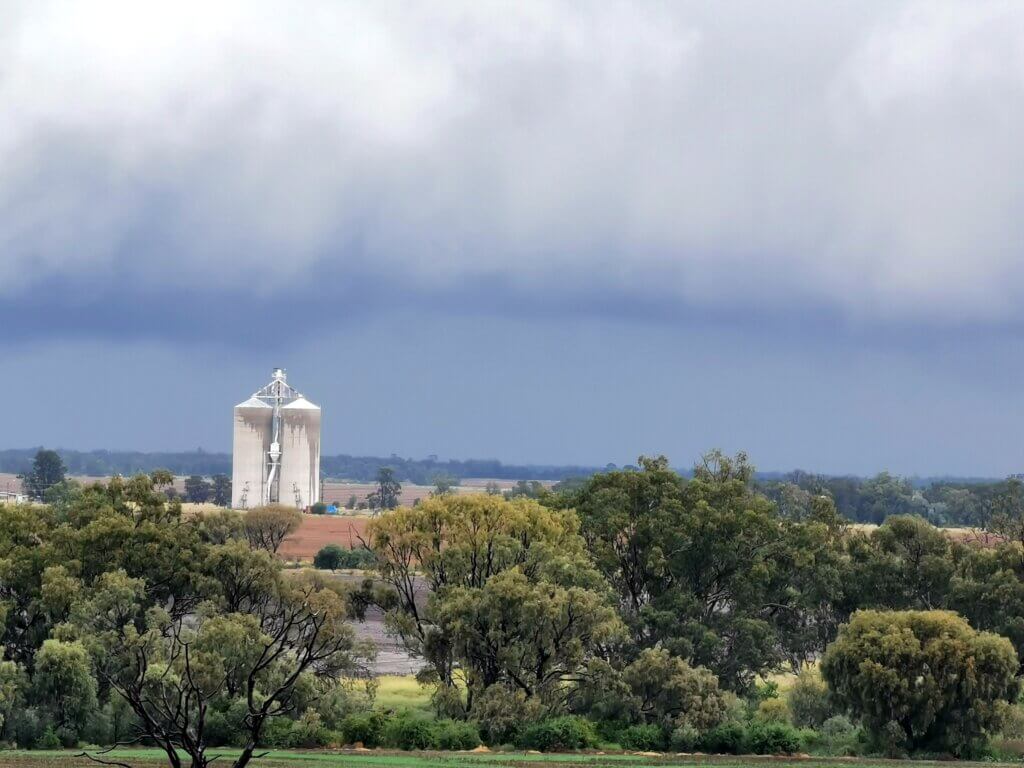
The final 25km into Moree along the busy Newell Highway, into the teeth of a stiff headwind, was the least favourite part of the journey so far. There seemed more trucks than cars, and they were often road trains with two or three trailers.
Moree is the major town of the affluent Moree Plains Shire, known for its artesian spas and art deco buildings. The town, built on the banks of the Mehi River, feature in the news about seven weeks ago when the Mehi rose 10.5 metres, flooding many homes and businesses. Riding through the town, I saw little evidence of the flooding event – something they are fairly accustomed to around there.
The goal of the first five days was to reach Keytah Farm, where I had been invited by owner and CEO of the Sundown Pastoral Company, David Statham to stay and learn about Keytah’s large scale, sustainable cropping operation, regenerative farming on a grand scale and much more. The next blog will feature our visit and what I found out and did on my rest day off the bike (other than finish writing this blog!).









Fantastic following your journey Kate.
Such beautiful scenery when off the main roads, Pike’s Creek looked perfect.
Shame about the weather you have encountered, hope that improves for you.
I hope you were able to enjoy the spas ay Moree, I’m sure your body would benefit.
Best wishes
Wendy W
I endorse Wendy’s comments re scenic cycling, arduous adventuring, wild weather & spa suggestions. Roll on…
Oh what a wonderful report, and such beautiful photographs. Thank you very much Kate.
Your grit is truly inspiring Kate, as you’ve faced the initial days of climbing in less than perfect weather. Great to see the spotlight on sustainable farming practices for this journey. Hope you find that rhythm as you head deeper west.
looks fairly heavy going Kate love Mum.
Hi Kate – that night in the honey shed was a bit weird. Our host had shelves of jars with pickled snakes heads in as well.
Hi Kate,
We will be with you in spirit during your trip, sharing the ups and downs and enjoying your beautiful photos and descriptions. Cheers, Michael and Angela
Amazing photos of beautiful country, Kate. The fabulous skies say it all, I hope they continue to inspire you.
Well done, Kate.
I’m heavily involved with industrial hemp in Australia and globally.
It will be a wonderful regenerative agricultural product, because no chemicals are needed to successfully grow it.
Hemp will transform Aussie agri-business.
Good luck with the ride
Hi Kate … Super work so far … on and off the bike. Fascinating accounts and ohotos already. All the very best! Travel well and safe.
Hi Kate- Nice pictures and very detailed day by day post, thanks.
Some times I don’t know what is more difficult, riding or writing!!!
I would like to make a trip like that!!
Kind regards
Great to ride with you Kate on your beautifully written blog. Tough few days of climbing to get the legs into journey mode. Best of luck
Gorgeous! Fantastic! Are you calling into or connecting with schools this adventure?
Some truly wonderful scenery Kate. Another amazing and inspiring journey you are on. Thank you for letting us get glimpses of it through your blog.
What a tough 5 days and you achieved your goal. Well done! Thanks for sharing the experience with us. Love the pics of Pikes Creek, I cant get enough of white tree trunks mirrored on the water. Some of the best reflections I’ve seen. Take care.
Hello Kate,
Following this with great interest from the UK. Thanks for taking the time to describe the journey in such detail with great photos.
Keep up the great work Kate!